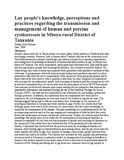| dc.description.abstract | Human cysticercosis due to Taenia solium is a major public health problem in Tanzania and other developing countries. However, little is known about T solium infection at the community level. This study assessed lay people's knowledge, perceptions and practices regarding transmission and management of neurological disorders in humans and white nodules in pig; in Mbeya rural district of Tanzania. The study respondents, participants and informants were individual keepers and non-pig keepers, people with neurological disorders, their caregivers and folk healers.
The 'study design was cross sectional and employed both quantitative and qualitative methods of data collection. A questionnaire with both structured and unstructured questions was used to collect quantitative data from the survey respondents, while narratives, focus group discussions and In-depth' interviews were used to collect qualitative data from the other categories of respondents who included the key informants, people with neurological disorders and their caregivers as well as selected respondents from the survey who were the participants in Focus Gf('UP Discussions.
Data analysis involved both thematic and content analysis for the qualitative data whereas the quantitative information was analyzed through the use of the Statistical Package for Social Sciences (SPSS). The data has been presented by use of frequencies, percentages, graphs and through pictorials. In addition, key quotations from the respondents have been used to underscore the rich ethnographic account and views of the studied as regards the topic.
The findings suggest that people in Mbeya rural district have knowledge on the existence of neurological disorders in humans and white nodules in pigs. Further, the results show that although people were aware of the existence of cysticercosis, they have poor knowledge on means for the transmission of the disease. This poor knowledge is a contributing factor for the accompanying practices such as free pig ranging and consumption of infected pork that could favour the transmission of human and porcine cysticercosis.
Further, the study revealed that their knowledge that people have on the causes for the transmission of neurological disorders in humans is responsible for the observed discrimination of people with neurological disorders by the community. This results from their beliefs and fear of the possibility of cross infection. Finally, it was noted that witchcraft was the perceived cause for neurological disorders m humans, while feeding pigs on unboiled banana peels among others, was the perceived cause for white nodules infections in pigs.
As a measure to manage cysticercosis, people switched from one health care system to another. The systems here included the folk, popular and professional sectors as noted in Kleinman's explanatory model. In management of neurological disorders in humans, foik healers reported to use herbs made of leaves and roots of various herbal plants for treatment of fits. Boiling and adding salt in pig feeds were measures taken by pig keepers to prevent their pigs from white nodules infections.
In summary, it can be argued that poor knowledge of people on causes for the transmission of cysticercosis is a contributing factor for practices that favour the transmission of human and porcine cysticercosis. On the other hand, discrimination and stigmatization of people with neurological disorders generates a vicious cycle where, poor knowledge on causes for the transmission hinders social acceptance, which in tum drives the patient to hide the disease and makes it difficult to increase people's awareness of it. Poor knowledge of people on causes for the transmission of cysticercosis and discrimination of people with neurological disorders contributes further to the transmission of human and porcine cysticercosis.
It is therefore, suggested that in order ,to control and eradicate human and porcine cysticercosis, the government and other stakeholders should take measures to ensure that people are educated on causes, mode of transmission and management of cysticercosis. Also, individuals and the community at large should observe cleanliness and good sanitation, in order to curb infectious diseases which are mainly caused by untidy conditions. | en_US |

